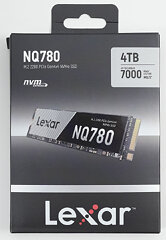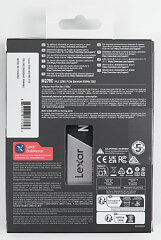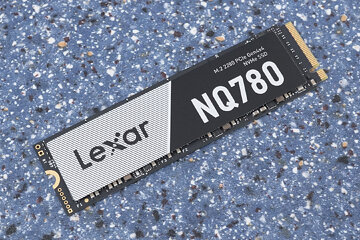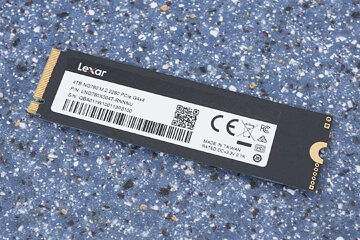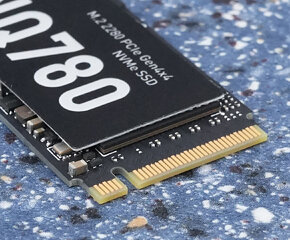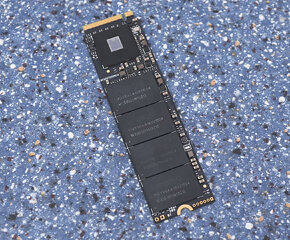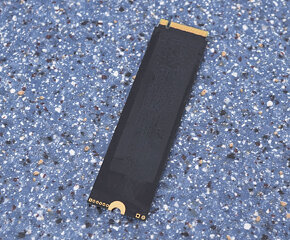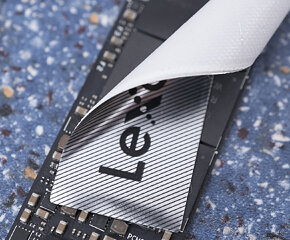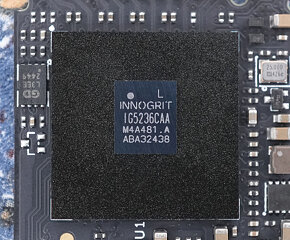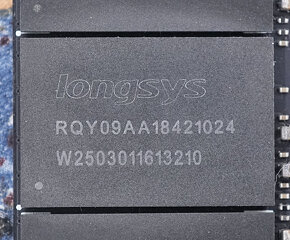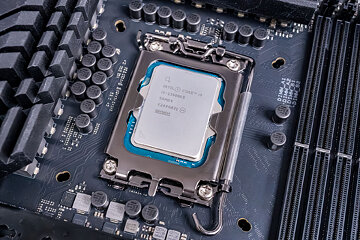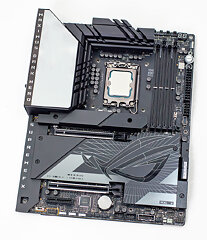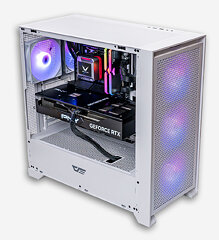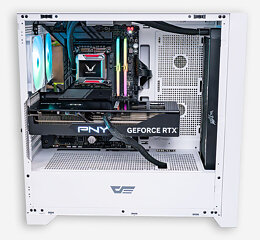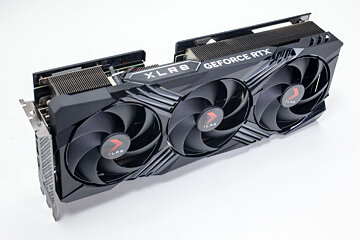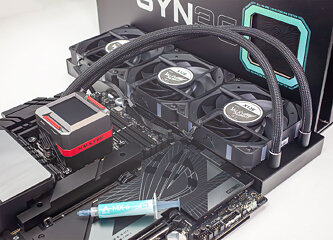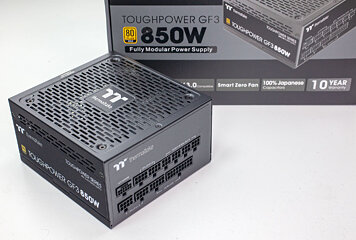 34
34
Lexar NQ780 4 TB Review
(34 Comments) »Introduction

Lexar has made a name for itself in the portable storage market—they are very well known for their SD cards and USB drives, so it's natural for Lexar to expand into other areas of flash storage, like consumer SSDs. Founded as a subsidiary of Micron, Lexar was sold to the Chinese parent company Longsys in 2017 and has been operating independently since.

Today we have on the testbed the Lexar NQ780 4 TB, which is a high-capacity M.2 NVMe drive at a competitive price. This SSD uses the older Innogrit IG5236 controller, paired with QLC NAND flash from Intel. This hardware combo looks a bit like there was some surplus inventory left and Lexar snapped up both at a good price, building the NQ780 from it. As host interface, PCI-Express 4.0 is used. Considering that this is a cost-optimized SSD, it's not unexpected that there is no DRAM cache available.
The Lexar NQ780 is available in capacities of 1 TB ($73), 2 TB ($135) and 4 TB ($240). The endurance is set to 600 TBW, 1200 TBW and 2400 TBW respectively. Lexar includes a five-year warranty with the NQ780 SSD.
| Specifications: Lexar NQ780 4 TB SSD | |
|---|---|
| Brand: | Lexar |
| Model: | LNQ780X004T-RNNNU |
| Capacity: | 4096 GB (3815 GB usable) No additional overprovisioning |
| Controller: | Innogrit IG5236 |
| Flash: | Intel 144-layer 3D QLC Longsys W2503011613210 |
| DRAM: | N/A, but 64 MB HMB |
| Endurance: | 2400 TBW |
| Form Factor: | M.2 2280 |
| Interface: | PCIe Gen 4 x4, NVMe 1.4 |
| Device ID: | Lexar SSD NQ780 4TB |
| Firmware: | 1.7.O.4F |
| Warranty: | Five years |
| Price at Time of Review: | $240 / $59 per TB |
Packaging
The Drive
The drive is designed for the M.2 2280 form factor, which makes it 22 mm wide and 80 mm long.
PCI-Express 4.0 x4 is used as the host interface to the rest of the system, which doubles the theoretical bandwidth compared to PCIe 3.0 x4.
On the PCB you'll find the controller and four flash chips, a DRAM cache chip is not available.
Lexar's sticker uses a white sticky tape that makes contact with the chips and has a shiny metal foil on top of that. This means less heat transfer, because heat has to travel through the white plastic adhesive first. The metal foil is also rather thin.
Chip Component Analysis
The Innogrit IG5236 is the company's first controller to support PCI-Express 4.0, released in 2020. It uses eight channels to maximize transfer rates and is fabricated on a 12 nm process at TSMC Taiwan.
The four flash chips are Intel QLC NAND with 144 layers. Each chip has a capacity of 1 TB.
Test Setup
| Test System SSD 2024 | |
|---|---|
| Processor: | Intel Core i9-13900KS Raptor Lake 6.0 GHz, 8+16 cores / 32 threads |
| Motherboard: | ASUS ROG Z790 Dark Hero BIOS 1102 |
| Memory: | 2x 16 GB DDR5-6000 |
| Graphics: | PNY GeForce RTX 4080 Super Verto OC |
| Cooling: | Valkyrie Syn 360 mm AIO |
| Thermal Paste: | Arctic MX-6 |
| Power Supply: | Thermaltake Toughpower GF3 850 W ATX 3.0 / 16-pin 12VHPWR |
| Case: | darkFlash DRX70 White |
| Operating System: | Windows 11 Professional 64-bit 23H2 VBS enabled (Windows 11 default) |
| Drivers: | NVIDIA: 552.12 WHQL |
Synthetic Testing
- Tests are run with a 20-second-long warm-up time (result recording starts at second 21).
- Between each test, the drive is left idle for 60 seconds, to allow it to flush and reorganize its internal data.
- All write requests contain random, incompressible data.
- Disk cache is flushed between all tests.
- During these tests, M.2 drives are tested with additional active fan-cooling, to ensure thermal throttling can't happen
Real-life Testing
- After initial configuration and installation, a disk image is created; it is used to test every drive.
- Automated updates are disabled for the OS and all programs. This ensures that—for every review—each drive uses the same settings, without interference from previous testing.
- Our disk image consumes around 700 GB—partitions are resized to fill all available space on the drive.
- All drives are filled with random data to 85% of their capacity. This is intentional, to run the drive in realistic operating conditions—nobody uses a nearly-empty SSD in their system. It also puts additional stress on the pseudo-SLC cache subsystem, because there is less free NAND space to work with.
- Partitions are aligned properly.
- Disk cache is flushed between all tests.
- In order to minimize random variation, each real-life performance test is run several times, with reboots between tests to minimize the impact of disk cache.
- All application benchmarks run the actual application and do not replay any disk traces.
- Our real-life testing data includes performance numbers for a typical high-performance HDD, using results from a Western Digital WD Black 1 TB 7200 RPM 3.5" SATA. HDDs are significantly slower than SSDs, which is why we're not putting the result in the chart, as that would break the scaling, making the SSDs indistinguishable in comparison. Instead, we've added the HDD performance numbers in the title of each test entry.
- During these tests, M.2 drives are tested with additional active fan-cooling, to ensure thermal throttling can't happen
Our Patreon Silver Supporters can read articles in single-page format.
Jul 24th, 2025 14:59 CDT
change timezone
Latest GPU Drivers
New Forum Posts
- RX 9000 series GPU Owners Club (1192)
- Need some help finding correct VBIOS for my RX580 (8)
- AI Job Losses: let's count the losses up, total losses to AI so far 94,000 and counting (58)
- What are these keycaps? (0)
- What's your latest tech purchase? (24356)
- 14900k high voltage (42)
- Your PC ATM (35541)
- 3D Printer Club (555)
- The Official Linux/Unix Desktop Screenshots Megathread (789)
- Power Outage Related ? (8)
Popular Reviews
- Noctua NF-A12x25 G2 PWM Fan Review
- MSI MPG B850I Edge Ti Wi-Fi Review
- Cougar OmnyX Review
- Thermal Grizzly WireView Pro Review
- UPERFECT UMax 24 Review
- TerraMaster F4-424 Max Review - The fastest NAS we've tested so far
- Sharkoon OfficePal C10 Review - Affordable and Decent
- Razer Blade 16 (2025) Review - Thin, Light, Punchy, and Efficient
- Upcoming Hardware Launches 2025 (Updated May 2025)
- Sapphire Radeon RX 9060 XT Pulse OC 16 GB Review - An Excellent Choice
TPU on YouTube
Controversial News Posts
- Some Intel Nova Lake CPUs Rumored to Challenge AMD's 3D V-Cache in Desktop Gaming (140)
- AMD Radeon RX 9070 XT Gains 9% Performance at 1440p with Latest Driver, Beats RTX 5070 Ti (131)
- AMD's Upcoming UDNA / RDNA 5 GPU Could Feature 96 CUs and 384-bit Memory Bus (115)
- NVIDIA GeForce RTX 5080 SUPER Could Feature 24 GB Memory, Increased Power Limits (115)
- NVIDIA DLSS Transformer Cuts VRAM Usage by 20% (99)
- AMD Sampling Next-Gen Ryzen Desktop "Medusa Ridge," Sees Incremental IPC Upgrade, New cIOD (97)
- NVIDIA Becomes First Company Ever to Hit $4 Trillion Market-Cap (94)
- Windows 12 Delayed as Microsoft Prepares Windows 11 25H2 Update (92)
